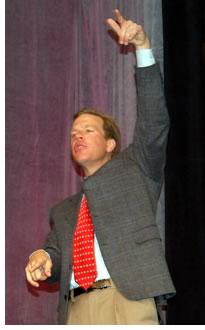

2/2006

 There
are five developmental levels to any organization, based on core values,
theme, and mood, argues organizational expert David Logan, PhD, ranging
from “prison mentality” to “nirvana,” he
says. He demonstrated at the closing plenary
session of the 2006 AIA Grassroots conference February 11 that the key
to moving up the ladder is taking the organization as a whole up one
step at a time.
There
are five developmental levels to any organization, based on core values,
theme, and mood, argues organizational expert David Logan, PhD, ranging
from “prison mentality” to “nirvana,” he
says. He demonstrated at the closing plenary
session of the 2006 AIA Grassroots conference February 11 that the key
to moving up the ladder is taking the organization as a whole up one
step at a time.
Logan, who works within the University of Southern California Marshall School of Business Department of Management and Organization, introduced his topic with the observation that architects as a group are at the main intersection of the 21st century, but, so far, the 21st century doesn’t know it. By explanation, he said, his research has shown him that one element of creating a happy and fulfilled organization is a great space within which to work.
Along with comfortable surroundings, good light, and fresh air are design amenities such as spaces conducive to impromptu interaction that help improve organizational culture. Unfortunately, only 6 percent of Americans report loving what they do. And a more refined understanding of the developmental levels of organizations will help architects lead their own firms more effectively and provide some insight into helping their clients improve their own organizational culture.
There are five stages of organization development, Logan explained. At the lowest level is despair and hostility—a prison mentality with the theme that life stinks. At the highest, level 5, there is no sense of “us” or “them” directed at individuals inside or outside the organization, only a sense of innocent wonderment that everything is working as it should. These vital organizations are rare, Logan said, and tend to prompt disbelief among outside observers. Logan’s matrix of core value relationships, themes, and moods across the five levels:

 Only four and five are “asset levels,” in Logan’s
parlance; the other three need to be moved up the scale to be effective
organizations. Understanding that groups move up (or down) only one step
at a time, Logan offered tactics for each stage:
Only four and five are “asset levels,” in Logan’s
parlance; the other three need to be moved up the scale to be effective
organizations. Understanding that groups move up (or down) only one step
at a time, Logan offered tactics for each stage:
Stage one: Get a new team; get out of that organizational prison.
Stage two: Identify individuals with
the potential to believe in themselves and work with them closely to
get them to recognize and celebrate their talents. Once you have a cadre
of people who believe “I’m
great,” tell them, “Yes, now reach out to your colleagues
and teach them to recognize their own areas of achievement.”
Stage three: Ask the people within the
organization who believe they are great as individuals, “What did you accomplish recently that
made you feel good, and why?” The complementarily, but riskier
question to ask, he said is “What pisses you off?” The divisive
potential is to have an organization in which the prevailing attitude
is “I’m great, and you’re not,” which you will
find in many academic environments. To overcome that as a leader, redefine
greatness until everyone feels as if he or she is at the top. Then find
shared values and develop a sense of group greatness.
Stage four: This is an “asset level,” so it has great productive
possibility, Logan asserts, and it can be made better. The down side
to a tribal pride of “we’re great,” similar to stage
three, is the corollary communicated to outside groups—explicitly
or implicitly—“and you’re not.” Similar to Maslow’s
hierarchy of human motivation, the top tier is actualization, which Logan
defines as “make history.” Go for history-making projects
so everyone in the organization can share part of their ultimate dream.
The example he gave for a stage five organization was the U.S. Olympic hockey team in 1980 that beat the Soviet Union and Finland to win the Gold Medal. They had a look of innocent awe, “Wow, did we score again? We’re winning?” Logan said. That kind of success without bravado is the ultimate organizational goal.
Copyright 2006 The American Institute of Architects.
All rights reserved. Home Page ![]()
![]()
For more
information on David Logan, visit the USC faculty Web site. ![]()
![]()